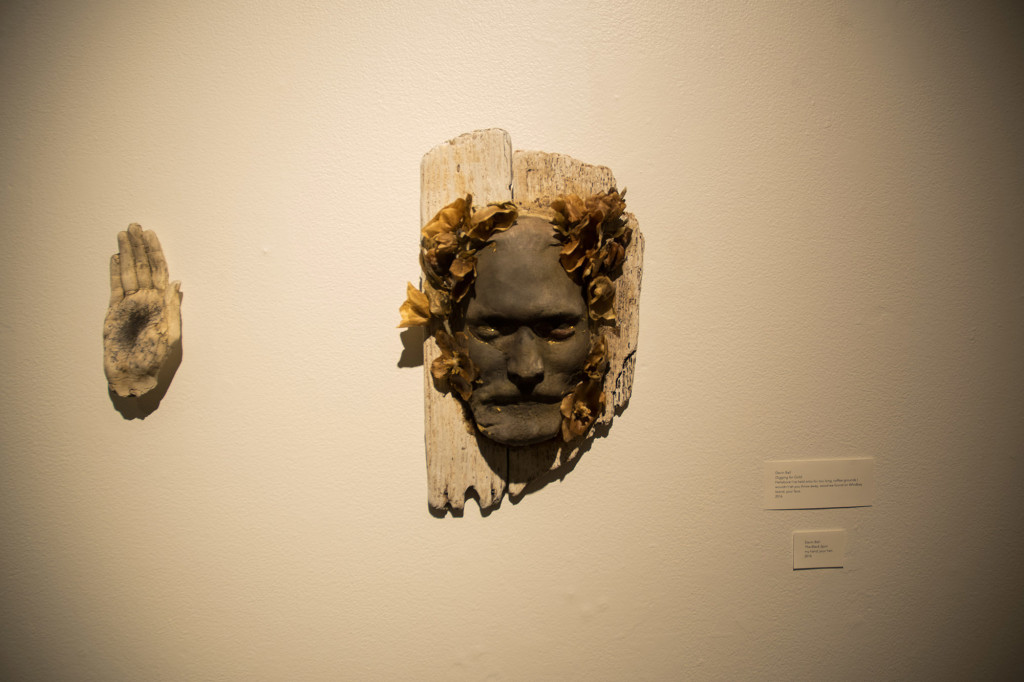A cup of coffee every morning. Her favorite bed sheets. Some wine that a friend gave her for her 21st birthday. The small material things in senior Rachel Young’s life manifest as preciousness in the art that she makes.

Devin Ball, “Digging for Gold”: Hellebore I’ve held onto for too long, coffee grounds I wouldn’t let you throw away, wood we found on Whidbey Island, your face.
An official class for just a handful of years now, professor Francisco Guerrero’s Advanced Studio Art Course culminates with an exhibit in an on campus gallery. But its course is not about spending a quarter trying to finish one piece to present at the end; instead, it’s about producing as much art as possible, without rules, themes or guidelines. The intention is for students to develop a process of creation, not just a product.
“I’m trying to help you design how you work, as opposed to help you make one object,” Guerrero said.
The idea here is that if students develop a process and a willingness to make art, they will be able to continue that process outside of college, where they won’t have the same kind of structure universities offer. According to Young, it’s a class that forces students into freedom.
Of course, with the focus on productivity and quantity of output, there also develops a tension between the concepts behind the art and the materials used to portray them. With really expensive products, there is more pressure to not screw up. Looking around the gallery at this year’s show, the art varies from paintings on canvases, to arrangements of hair, to simple materials like coffee grounds and pillowcases.
Several of the students chose to use materials that were not expensive, but were precious to them. Young produced a series of embroidered fabrics and to see them is to know that they are special. But why? What becomes apparent in Young’s work is that there is more to it than just thread and fabric. Young used artifacts from her life to fill the physical art with the concepts and meanings behind its creation, like preciousness and femininity.
She used special wines and teas as dyes. She used her own bed sheets and t-shirts as the fabrics. The viewer can’t name what makes it special, but they can tell that it is.
“[It] gave me a certain reverence towards the pieces that maybe I think they wouldn’t have taken on if I’d bought some really nice cloth from the store or something,” Young said. “I think it really changed how I worked with it and then made the pieces themselves a lot better.”
Senior mechanical engineering major Devin Ball also used precious material from his life to create his art. His work sometimes falls under the umbrella term of mixed-media, but to him that diminishes a lot of what he’s trying to do.
“What I use is a large part of what I think I’m doing,” Ball said. “And that’s kind of like enshrining experiences that I’ve had and these objects that I’ve encountered while having those experiences.”
Both Ball and Young just finished taking the class for a second time, an option available because of the class’ nature. Both of them are continuing the work that they began in their first time through the course. For Ball, one of those things is more deeply exploring the tension between preserving something and the knowledge that by trying to preserve something, you are fundamentally changing it.
All of his materials are artifacts from his life. They are things that mean something to him and only him. At the same time, however, the viewer can see the work, and know that even though they personally have no connection to the materials, they are deeply precious.
Ball’s entire artist statement is a quote from F. Scott Fitzgerald. It says, “I’m not sentimental—I’m as romantic as you are. The idea, you know, is that the sentimental person thinks things will last—the romantic person has a desperate confidence that they won’t.”
Despite the preciousness of the chosen materials, the conceptual meaning behind them is part of what gives the students the freedom
to create.
“I think some people kind of get stuck in this rut of setting out on this really ambitious thing that they spend a lot of time on, and they miss out on a lot of experimentation that I think is really important when you’re trying to establish an art practice,” Ball said.
This is what the course does for many students—it gives them an outlet to create without consequence, and develop the skills they need to be artists outside of Seattle U. The Advanced Studio Art Exhibit will be available for viewing until April 8 and is open to students in the Vachon Gallery in the Fine Arts Building.
Lena may be reached at lbeck@su-spectator.com








